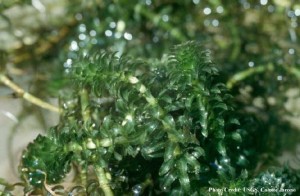
Hydrilla is an invasive species that hasn't made it to the Great Lakes. Biologists want to keep it that way. Photo: Collete Jacono, USGS
By Jeff Gillies
jeffgillies@gmail.com
Great Lakes Echo
Oct. 1, 2009
Editors note: This story is part of a series relevant to the International Joint Commission’s Oct. 7 and 8 biennial meeting in Windsor.
When Matt Preisser thought he saw a photo of a potential Great Lakes invasive species in a Michigan newspaper, he tracked it down and checked it out.
“The plants in the photo were suspiciously similar to hydrilla,” said Preisser, who works for Michigan’s Aquatic Nuisance Control Program. “It was close enough that I didn’t want to pass it up and miss the chance to find out if that’s really what it was.”
It wasn’t. But Preisser’s willingness to sniff out a fishy looking plant in a newspaper photo shows how serious Great Lakes biologists are about keeping this invader out.
Hydrilla is just the kind of organism requiring a coordinated response that will be discussed next Wednesday in Windsor at the biennial meeting of the International Joint Commission. That’s a binational group of scientists and policy advisers who advise the U.S. and Canadian governments on Great Lakes issues.
Hydrilla can form floating mats as large as 100 acres. The mats block sunlight from other plants and are too dense to serve as fish habitat, Preisser said. They clog drinking water and irrigation systems.
Native to Asia, Europe, Africa and Australia, hydrilla grows in ropy stems covered in green leaves. It first invaded the U.S. in Florida around 1960 when unwitting aquarium enthusiasts likely dumped the plant into local waterways.
Once it took root, it reproduced like mad and crowded out native plants and wildlife. It has since spread to 19 states and is knocking on the Great Lakes’ door.
Hydrillia is almost impossible to get rid of once it’s established, Preisser said.
“In Florida and some of the other southern states it’s very extensive, and they’ve spent millions and millions of dollars trying to control it,” he said. “It’s still there, and these are annual efforts.”
So Great Lakes officials want a basin-wide plan that spells out exactly who does what when someone spots hydrilla so they can oust it before it gets too comfortable.
That plan will resolve key issues well ahead of invasions so they can’t bog down the response once the exotic species show up.
Those issues include permits, conflicts between local, state and federal regulations, working out who’s in charge of a response and who’s going to pay for it, said Mark Burrows, an International Joint Commission scientist and secretary of the Council of Great Lakes Research Managers.
Clearing up those potential show-stoppers ahead of time will help prevent a messy situation where one state or nation knows about a hydrilla outbreak but its neighbors don’t find out until it’s too late.
“It causes a lot of bad relations and missed opportunities for response if everybody’s not fully informed on both sides of the border,” Burrows said.
The Joint Commission isn’t the first Great Lakes player to hatch a plan anticipating hydrilla’s arrival.
In 2004, Michigan’s Hydrilla Task Force drafted a “rapid response” plan to determine which state department would do what if hydrilla was found in the state.
But the plan still doesn’t say who will pay for it.
“We can’t say that we would rapidly respond to hydrilla if it was found because we have no source of funding,” said Roger Eberhardt, environmental quality specialist in Michigan’s Office of the Great Lakes.
Luckily, Michigan is still hydrilla-free. But the plant has reared it’s head in Pennsylvania, Wisconsin and Indiana.
When Indiana officials found hydrilla in Lake Manitou in 2006, they followed Michigan’s plan to squash the outbreak. Three years of chemical treatment and restricted boating access later, the infestation is more than 90 percent controlled, and it hasn’t spread to any other lakes in the state.
Indiana’s success is encouraging for cash-strapped states like Michigan.
“In Indiana, they didn’t have funding either,” Eberhardt said. “But they kind of cobbled together some money from their current programs.”
Some federal help could be on the way. Congress is considering $475 million for Great Lakes restoration, $60 million of which would go to fighting invasive species. One priority for that funding is rapid response plans, said Hugh MacIsaac, co-chair of the International Joint Commission’s rapid response work group.
“This would, for the first time, give states money to develop the types of plans that…should be done to prepare for when the next bad invader comes in,” he said.
Pingback: False alarm: Horrific, devil of a fish not yet in Great Lakes | Great Lakes Echo
Pingback: International Joint Commission examines Great Lakes water quality | Great Lakes Echo